Coronavirus (COVID-19): modelling the epidemic (issue no.81)
Latest findings in modelling the COVID-19 epidemic in Scotland, both in terms of the spread of the disease through the population (epidemiological modelling) and of the demands it will place on the system, for example in terms of health care requirement.
Coronavirus (COVID-19): modelling the epidemic in Scotland (Issue No. 81)
Background
This is a report on the Scottish Government modelling of the spread and level of Covid-19 in Scotland. This updates the previous publication on modelling of Covid-19 in Scotland published on 2nd December 2021. The estimates in this document help the Scottish Government, the health service and the wider public sector plan and put into place what is needed to keep us safe and treat people who have the virus.
This edition of the research findings focuses on the epidemic as a whole, looking at estimates of R, growth rate and incidence as well as local measures of change in the epidemic. It is divided into three sections: one looking at recent periods, where the Delta variant makes up the majority of cases in Scotland; the second section looks at the Omicron variant and how this might impact on Scotland; and the third section covers other modelling for which the methodology is not affected by which variant makes up the majority of cases in Scotland. We will update on a weekly basis as we know more about the Omicron variant.
Key Points
Based on the Delta variant being the majority of cases
- The reproduction rate R in Scotland is currently estimated as being between 0.9 and 1.1, as of 23rd November. The lower estimate has increased since last week.
- The number of new daily infections for Scotland is estimated as being between 104 and 142 as at 23rd November, per 100,000 people.
- The growth rate for Scotland is currently estimated as between -3% and 0% as at 23rd November. The upper limit has decreased since last week.
- Hospital and ICU occupancy have fallen slightly. There continues to be uncertainty over hospital occupancy and intensive care in the next two weeks.
- Modelled rates of positive tests per 100K using data to 6th December indicate that, for the week commencing 19th December 2021, 30 of the 32 local authorities are expected to exceed 50 cases per 100K with at least 75% probability. The exceptions are Orkney Islands and Shetland Islands.
- 29 local authorities are expected to exceed 100 cases per 100K with this probability. The exceptions are Na h-Eileanan Siar, Orkney Islands and Shetland Islands.
- Three local authorities are expected to exceed 300 cases per 100K with at least 75% probability. These are East Ayrshire, East Dunbartonshire and Falkirk.
- There are no local authorities which are expected to exceed 500 cases per 100K with at least 75% probability.
- Modelling of long Covid estimates that on 26th December 2021 between 1.5% and 3.1% of the population are projected to self-classify with long Covid for 12 weeks or more after their first suspected Covid infection in Scotland. The lower and upper limits of the estimate of the proportion of the population with long Covid are unchanged from last week.
Based on the Omicron variant
- Using data to 6th December, we can estimate a doubling time for Scotland of between 2.18 - 2.66 days using S-gene target failure as a proxy for Omicron cases.
- Based on projections given the doubling time above, Omicron is likely to make up the majority of cases in Scotland, and this could occur between mid-December and early January 2022.
Other modelling
- Average contacts from the most recent Panel A cohort of the Scottish Contact Survey (week ending 1st December) indicate an average of 4.8 contacts.
- Mean contacts within the home have increased by 7% whereas work contacts have decreased by 8% in the last two weeks. Contacts within the other setting (contacts outside home, school and work) have remained at a similar level over the same period.
- Contacts for those in the 18-29 age group have almost doubled with a current level of 6.6 mean contacts.
- The biggest increase interactions is seen between the those under 18 with individuals within the 18-29 age group, with contacts at least three times higher between these age groups.
- The biggest changes in the proportion of participants visiting different locations is seen in those visiting shops. Visits to a non-essential shop increased from approximately 42% to 46% and visits to essential shops increased from 86% to 89% in the last two weeks.
- The number of people wearing a face covering where they have at least one contact outside of the home has increased in the last two weeks from 83% to 85%.
- Nationwide, wastewater Covid-19 levels have remained static, with
the week ending on 7th December seeing levels of around 81 million gene copies per person per day (Mgc/p/d), about the same as the
78 Mgc/p/d seen the previous week.
Recent cases
Figure 1 shows the number of Covid-19 cases reported in Scotland between November and December 2021. The vertical dashed lines indicate the cut off points for each of the modelling inputs; after these dates, the number of cases is not incorporated into the outputs.
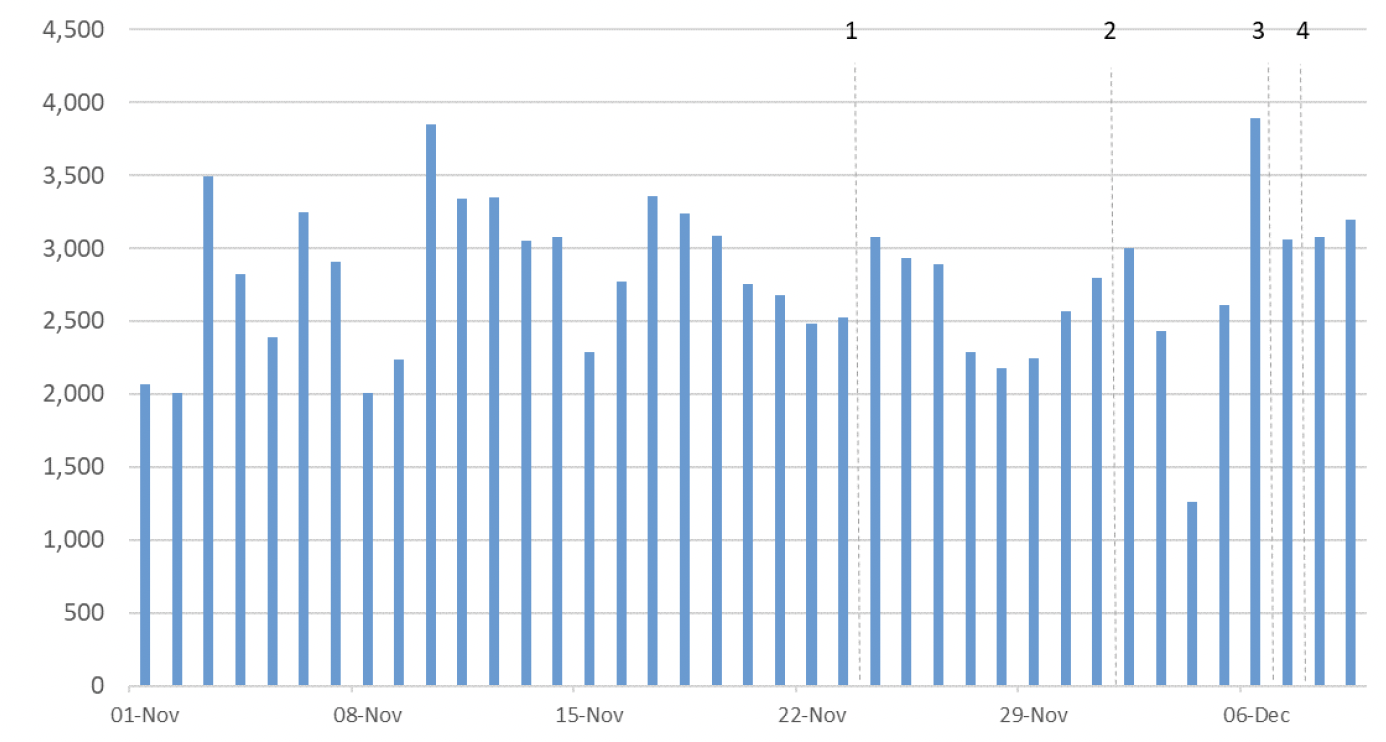
R, growth rate and incidence are as of 23rd November (dashed line 1). The Scottish Contact Survey uses data to 1st December (dashed line 2).
The Scottish Government modelling of infections, hospitalisations and ICU beds, the long Covid analysis, the medium term projections and the modelled rates of positive tests per 100K use data to 6th December (dashed line 3). Wastewater analysis used data to 7th December (dashed line 4).
Figure 2 shows the number of confirmed Omicron cases and those cases that are under investigation.
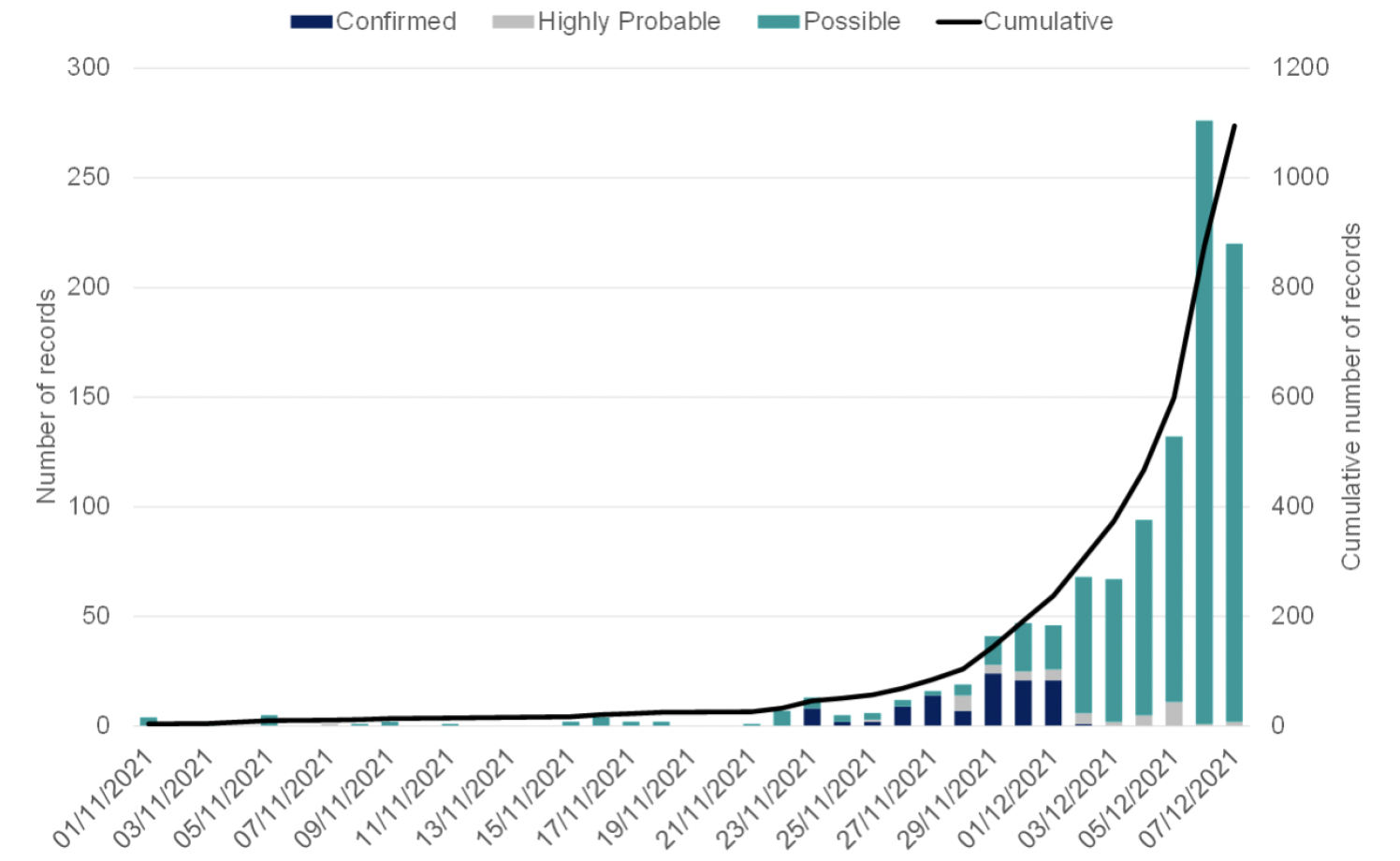
Source: Scottish Government Covid-19 Evidence Report, published 10th December 2021
Overview of Scottish Government Modelling
Modelling outputs are provided here on the current epidemic in Scotland as a whole, based on a range of methods. Because it takes a little over three weeks on average for a person who catches Covid-19 to show symptoms, become sick, and either die or recover, there is a time lag in what our model can tell us about any change in the epidemic, e.g. any impact of the Omicron variant. Therefore a new section has been included covering what we know of this new variant.
The first section of this report covers a range of modelling where Delta makes up the majority of cases:
- The UK Health Security Agency (UKHSA) consensus is shown, which uses a range of data in its estimates of R and the growth rate.
- The logistical model utilises results from the epidemiological modelling, principally the number of new infections. The results are split down by age group, and the model is used to give a projection of the number of people that will go to hospital, and potentially to ICU.
- We also provide the SPI-M projection of infections and deaths, and the local modelling outputs for estimated cases per local authority in two weeks' time. These assume that Delta remains the majority of cases.
The second section of this report covers Omicron:
- Looking at estimates of the doubling time of this variant, using the data available for Scotland.
- It also projects this forward into the future to estimate the proportion of Omicron cases in the coming weeks.
We also include in this report other modelling which will not be affected by Omicron:
- The Scottish Contact Survey (SCS) is used to inform a modelling technique based on the number of contacts between people. Over time, a greater proportion of the population will be vaccinated. This is likely to impact contact patterns and will become a greater part of the analysis going forwards.
- We also report on levels of Covid-19 RNA in wastewater around Scotland and compare it to the 7-day average daily new cases.
What the modelling tells us about the epidemic based on Delta being the majority of cases
The R value and growth rates are estimated by several independent modelling groups based in universities and the UKHSA. Estimates are considered, discussed and combined at the Epidemiology Modelling Review Group (EMRG), which sits within the UKHSA. These are based on data to 23rd November, a week in which over 99% of reported cases in Scotland were estimated to be of the Delta variant.
UKHSA's consensus view across these methods, was that the value of R as at 23rd November[2] in Scotland was between 0.9 and 1.1 (see Figure 3)[3].
R is an indicator that lags by two to three weeks and therefore should not be expected to reflect recent fluctuations.
This week the Scottish Government presented two outputs to EMRG. The first uses confirmed cases, as published by Public Health Scotland (PHS), and deaths from National Records Scotland (NRS). The second uses instead wastewater data to estimate the number of cases, and deaths from NRS. Both outputs are shown in Figures 3 and 4.
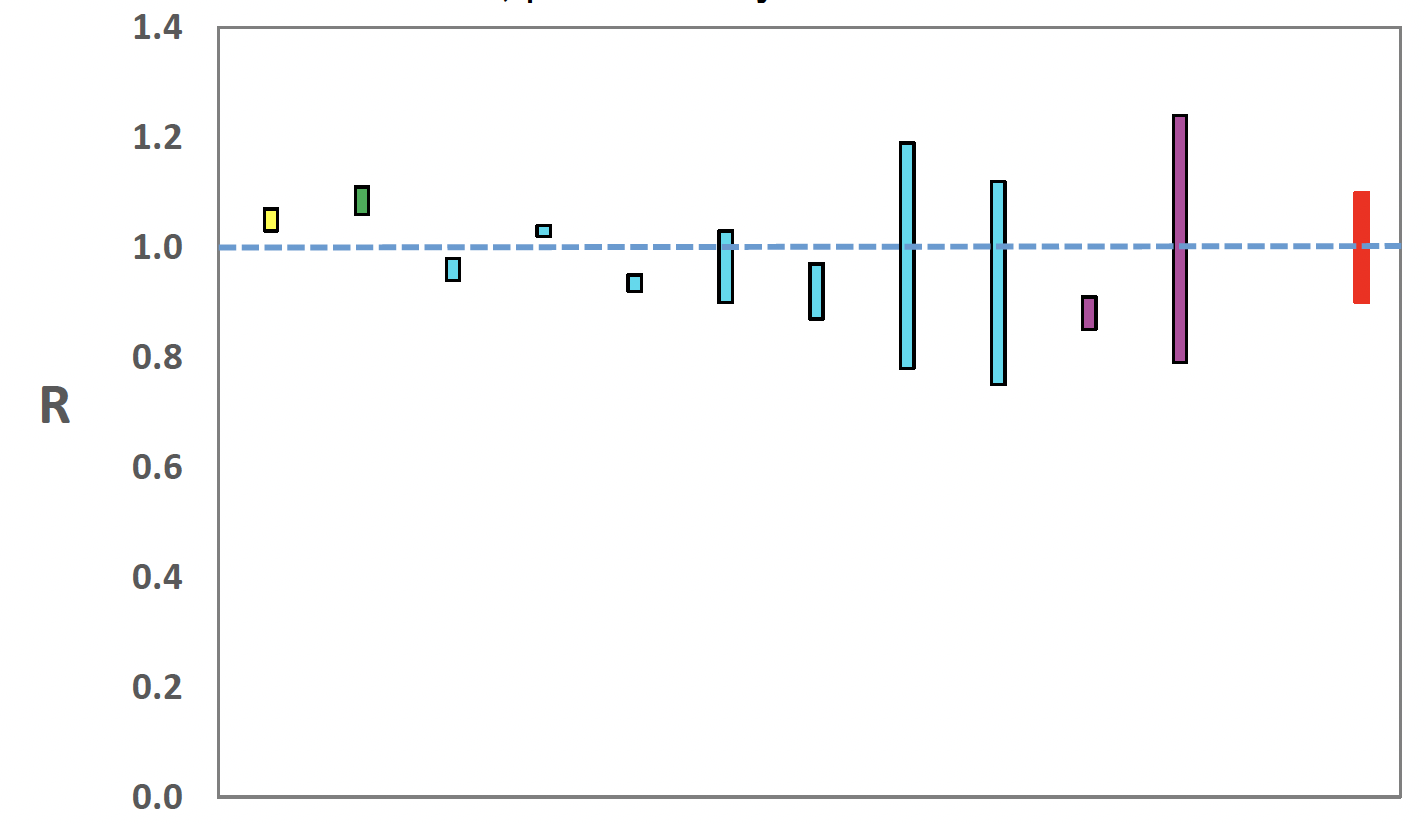
Source: EMRG
The various groups which report to the EMRG use different sources of data in their models to produce estimates of incidence (Figure 4). UKHSA's consensus view across these methods, as at 23rd November, was that the incidence of new daily infections in Scotland was between 104 and 142 new infections per 100,000. This equates to between 5,700 and 7,800 people becoming infected each day in Scotland.
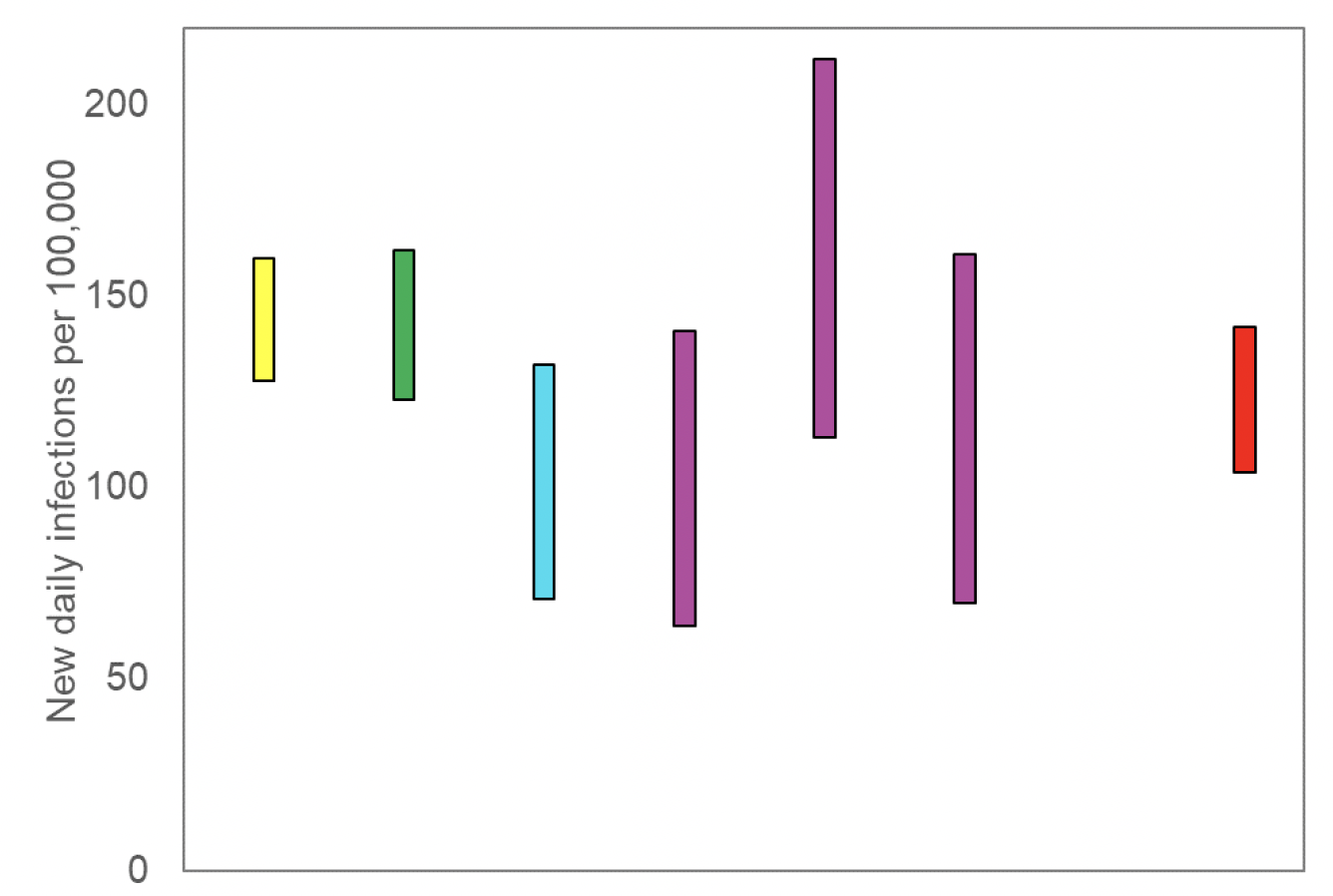
Source: EMRG
The consensus from UKHSA for this week is that the growth rate in Scotland is between -3% and 0% per day as at 23rd November. The upper limit has decreased since last week.
What the modelling tells us about estimated infections as well as Hospital and ICU bed demand for Delta
The Scottish Government assesses the impact of Covid-19 on the NHS in the next few weeks in terms of estimated number of infections. Figure 5 shows three projections over the two weeks to 20th December, rather than a longer period due to the uncertainty around both the Omicron variant and the potential impact of Christmas.
'Central' assumes that infections will plateau. 'Worse' assumes a rise in transmission from the current level. 'Better' assumes a drop in transmission[5]. As it is too soon to take account of the potential impact of the Omicron variant on hospitals and ICU etc, all three scenarios are based on the Delta variant. Therefore depending on the current number of Omicron cases and its characteristics, the actual number of infections, hospital occupancy and ICU occupancy over the next few weeks could be higher than projected here.
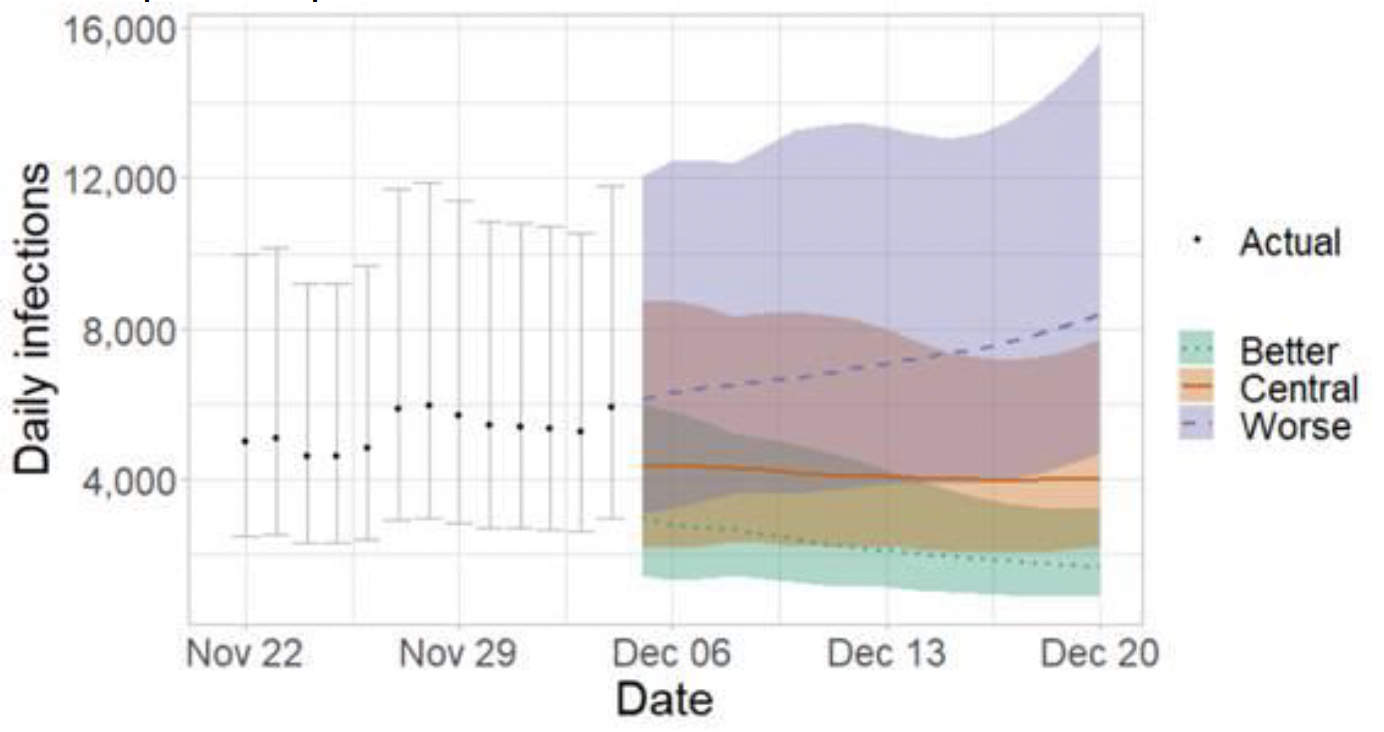
Figure 6 shows the impact of the projections on the number of people in hospital. The modelling includes all hospital stays, whereas the actuals only include stays up to 28 days duration that are linked to Covid-19.
There continues to be uncertainty over hospital occupancy and intensive care in the next two weeks.
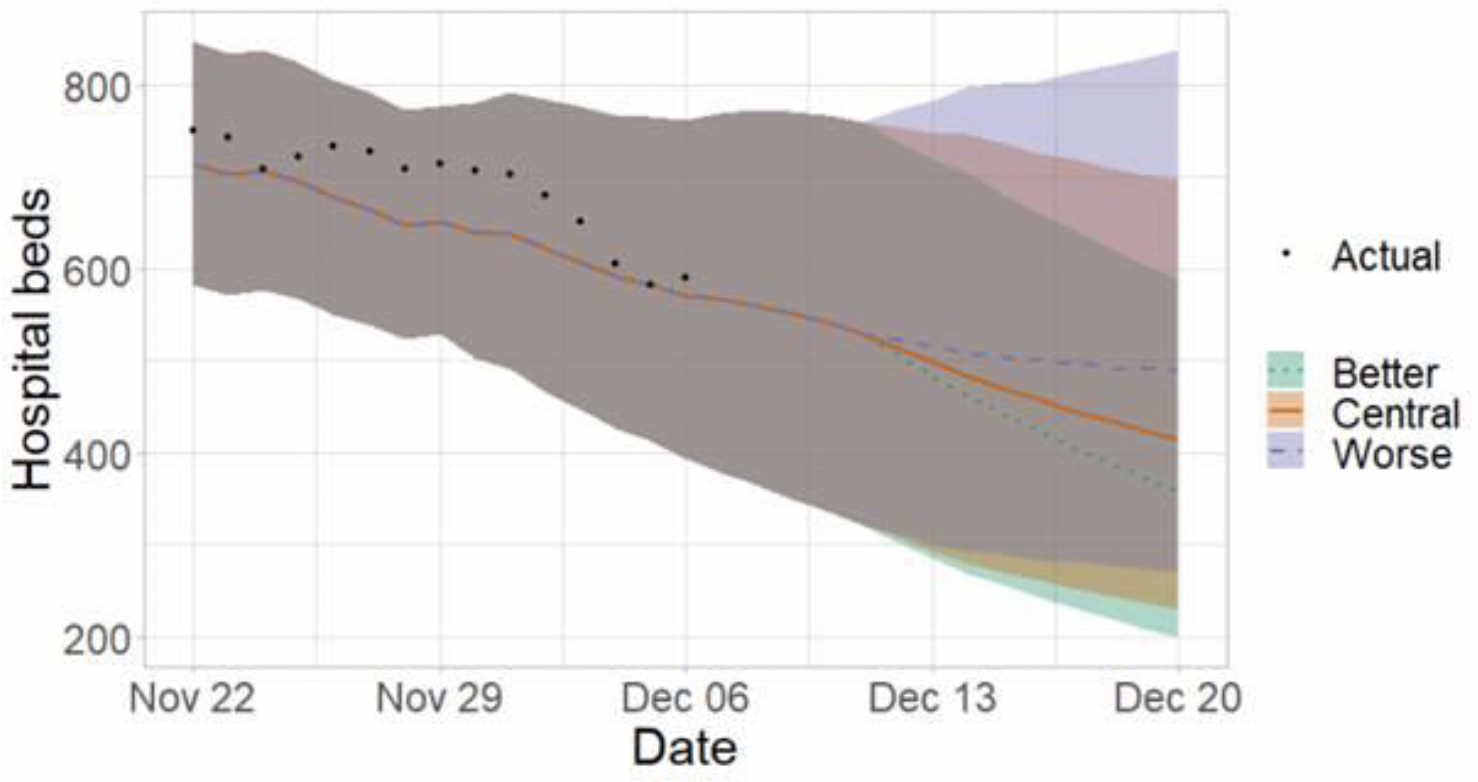
Figure 7 shows the impact of the projection on ICU bed demand.
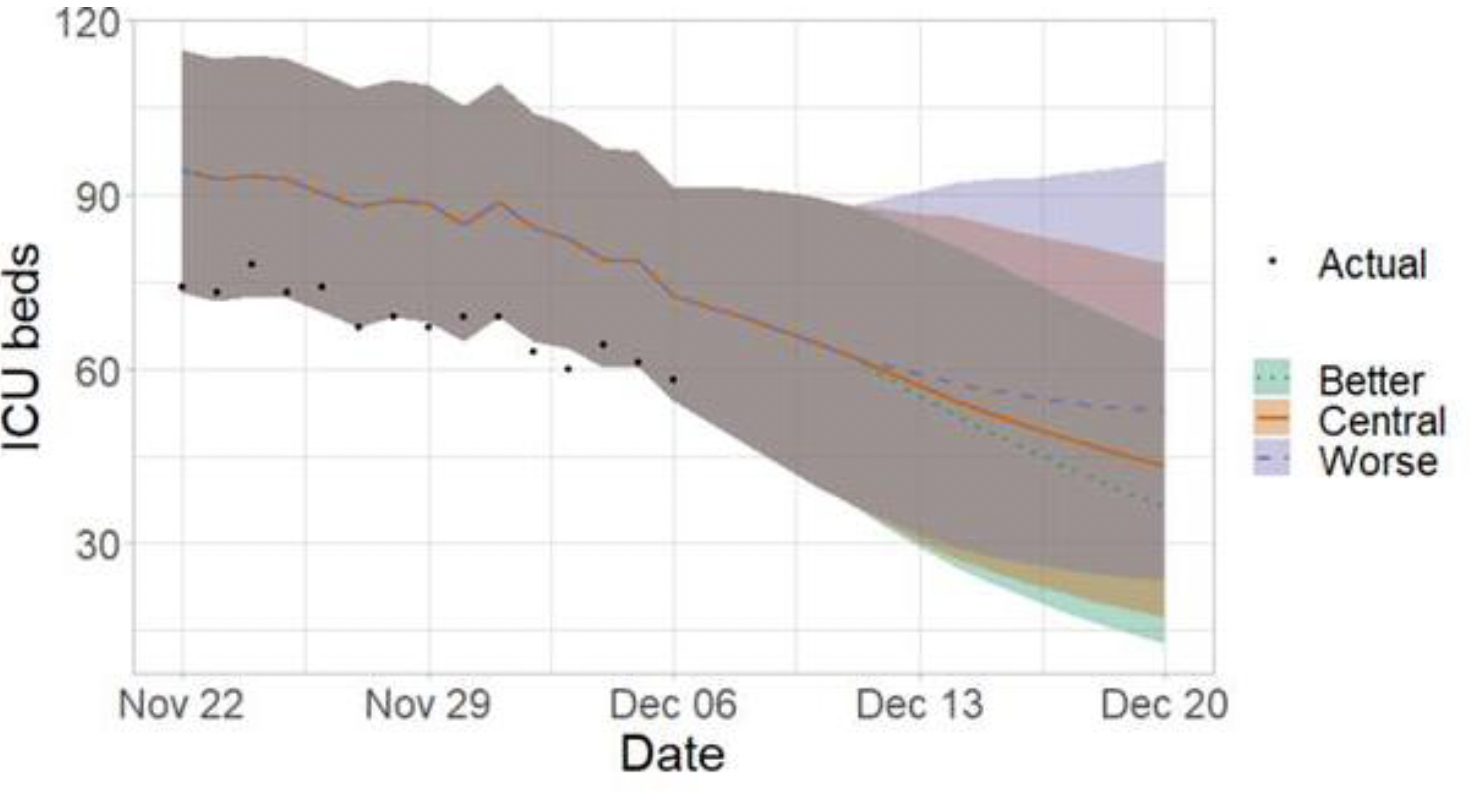
The methodology for estimating projections is included in the Technical Annex. Also included is a comparison of the actual data against historical projections.
What the modelling tells us about projections of hospitalisations and deaths in the medium term
SPI-M produces projections of the epidemic[9] (Figures 8 and 9), combining estimates from several independent models (including the Scottish Government's logistics modelling, as shown in Figures 5 to 7). These projections are not forecasts or predictions. They represent a scenario in which the trajectory of the epidemic continues to follow the trends that were seen in the data up to 6th December and do not include the effects of any future increase in the Omicron variant, or future policy or behavioural changes.
The delay between infection, developing symptoms, the need for hospital care, and death means they cannot fully reflect the impact of behaviour changes in the two to three weeks prior to 6th December. Projecting forwards is difficult when the numbers of admissions and deaths fall to very low levels, which can result in wider credible intervals reflecting greater uncertainty. The interquartile range should be used, with judgement, as the projection from which estimates may be derived until 21st December.
These projections include the potential impact of vaccinations over the next few weeks. Modelling groups have used their expert judgement and evidence from UKHSA, Scottish Universities & Public Health Scotland, and other published efficacy studies when making assumptions about vaccine effectiveness.
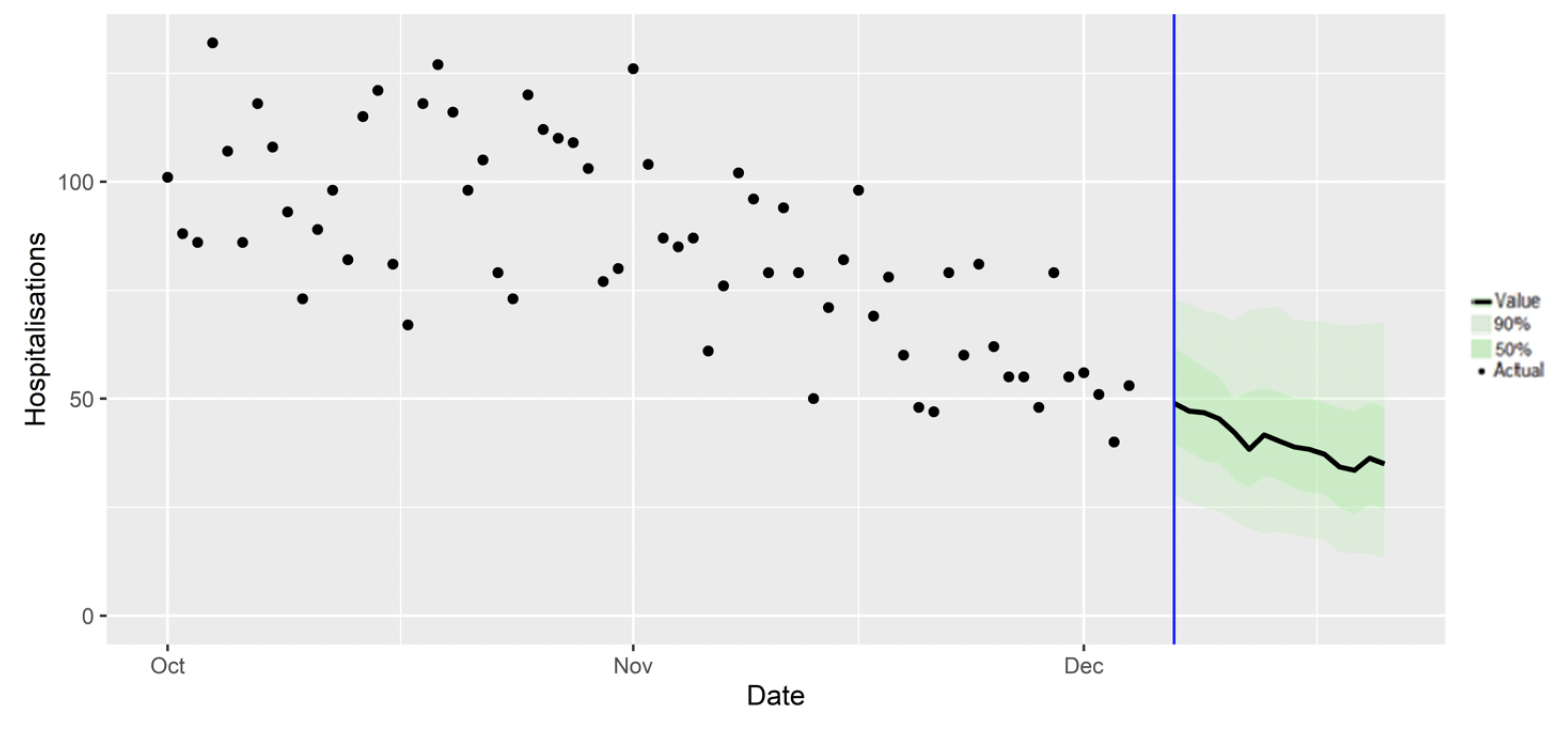
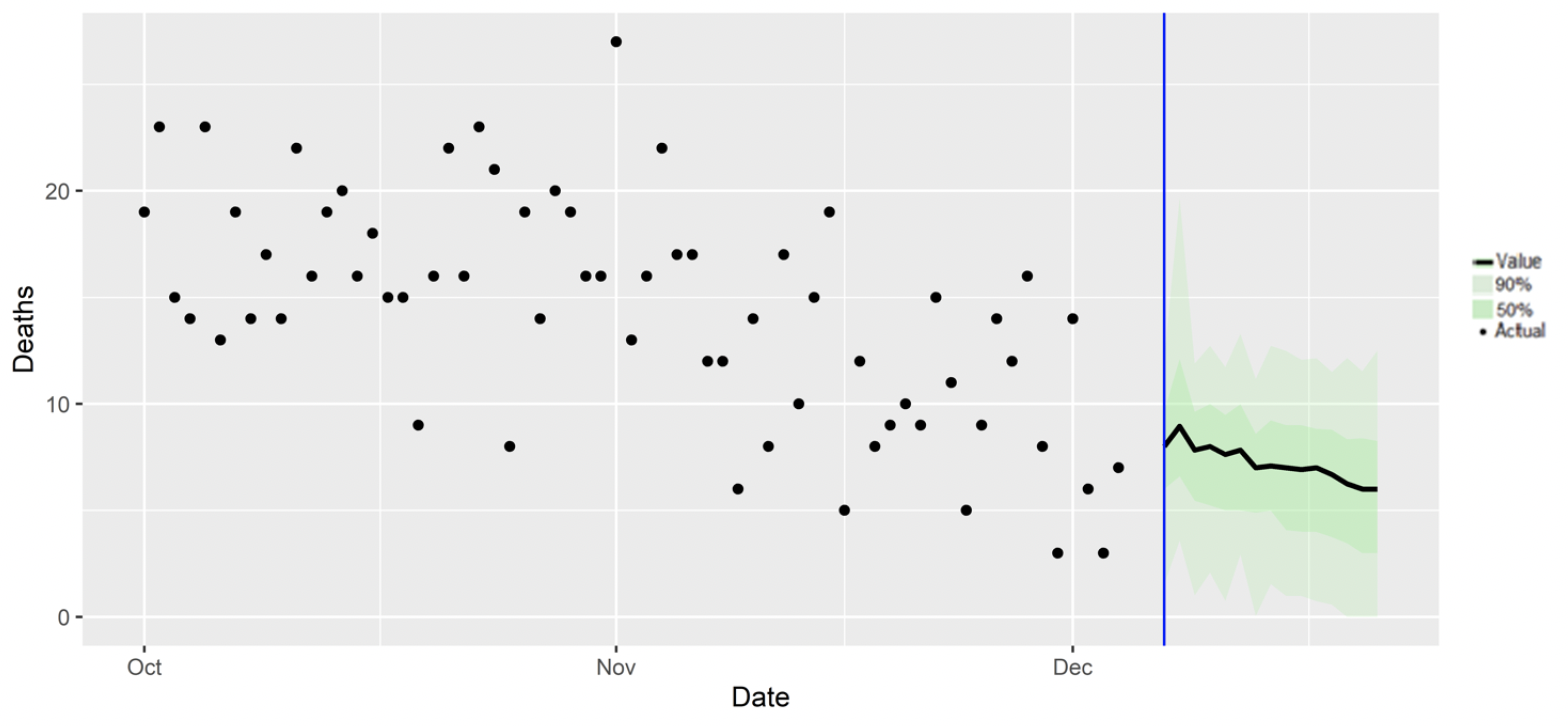
What we know about which local authorities are likely to experience high levels of Covid-19 in two weeks' time
We continue to use modelling based on Covid-19 cases and deaths using data to 6th December from several academic groups to give us an indication of whether a local authority is likely to experience high levels of Covid-19 in the future. This has been compiled via UKHSA into a consensus. In this an area is defined as a hotspot if the two week prediction of cases (positive tests) per 100K population is predicted to exceed a threshold, e.g. 500 cases.
There is uncertainty in regions with smaller populations, and hence lower test counts, in particular in regions such as Na h-Eileanan Siar, Orkney Islands and Shetland Islands.
Modelled rates of positive tests per 100K using data to 6th December (Figure 10) indicate that, for the week commencing 19th December 2021, 30 of the 32 local authorities are expected to exceed 50 cases per 100K with at least 75% probability. The exceptions are Orkney Islands and Shetland Islands.
29 local authorities are expected to exceed 100 cases per 100K with this probability. The exceptions are Na h-Eileanan Siar, Orkney Islands and Shetland Islands.
Three local authorities are expected to exceed 300 cases per 100K with at least 75% probability. These are East Ayrshire, East Dunbartonshire and Falkirk.
There are no local authorities which are expected to exceed 500 cases per 100K with at least 75% probability[10].
These models are based on a projection where the Delta variant makes up the majority of cases.
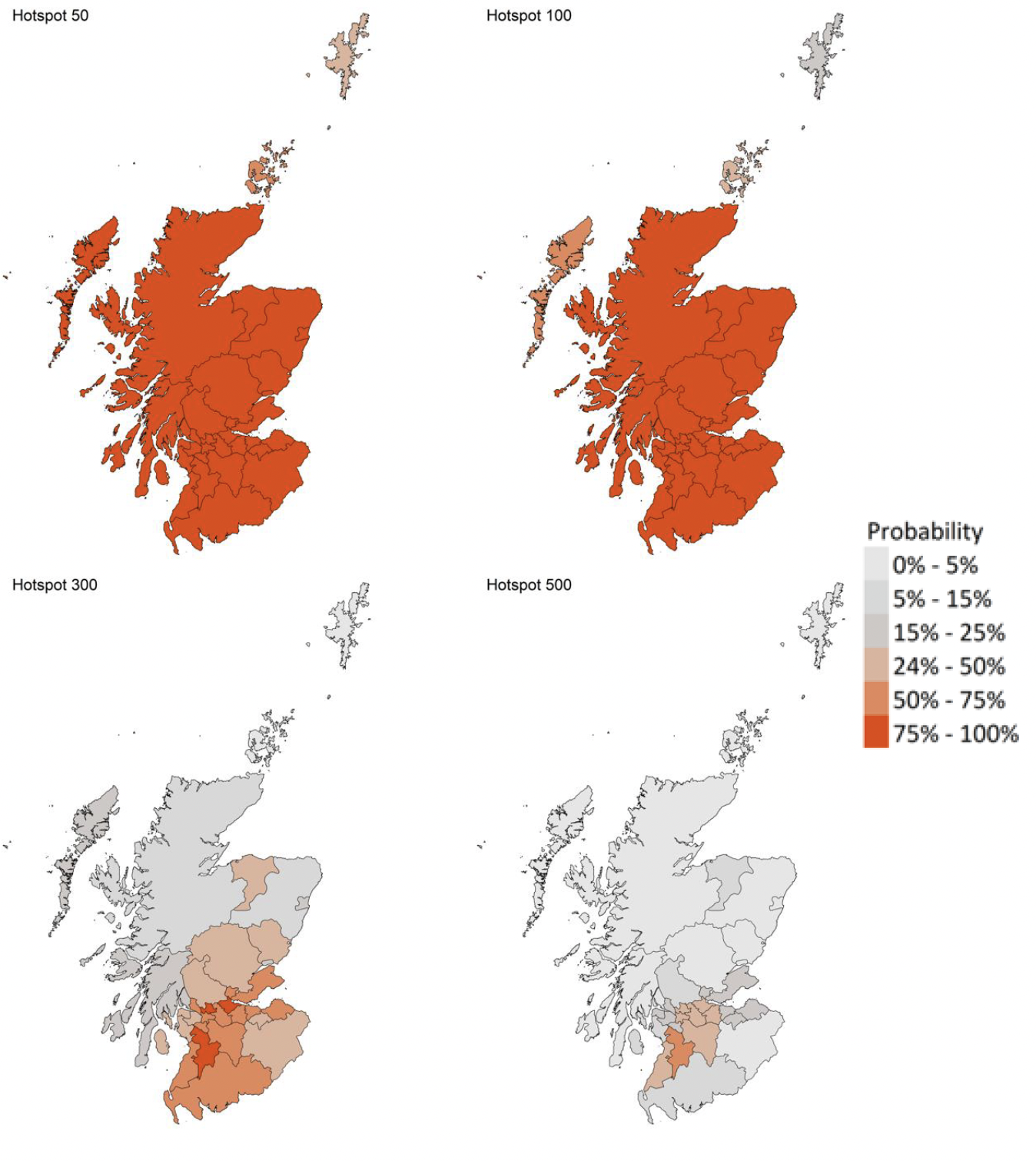
What estimates do we have of the number of people experiencing long Covid symptoms?
The Scottish Government is modelling the number of people likely to experience long Covid symptoms. This gives a projection of estimated self-reported long Covid rates in the future, based on Scottish Government medium term projection modelling, as set out in Figure 11.
This modelling estimates that at 26th December 2021 between 81,000 (1.5% of the population) and 172,000 (3.1%) people are projected to self-classify with long Covid for 12 weeks or more after their first suspected Covid infection in Scotland.
The lower and upper limits of the estimate of the proportion of the population with long Covid are unchanged from last week.
These are preliminary results, further data on rates of long Covid and associated syndromes will be added as research emerges, eg around the Omicron variant.
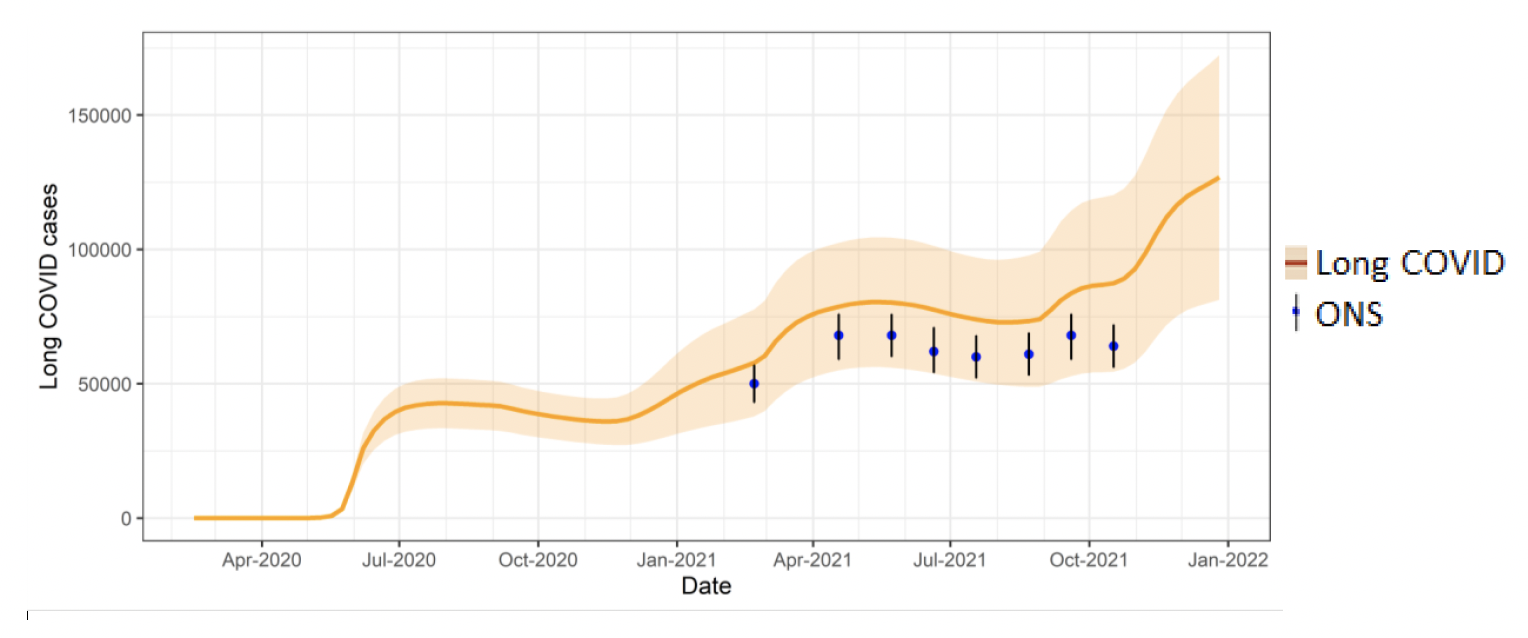
See the Technical Annex in issue 73 for information about the methodology.
What we already know about the Omicron variant
Latest data shows there have been 109 confirmed, 48 highly probable, and 938 possible Omicron variant cases reported in Scotland, for a total of 1,095 confirmed or possible cases. This is based on specimens collected to 7 December 2021 and reported up to 9 December 2021[11].
Based on data to 6th December, we can estimate a doubling time for Scotland of between 2.18 - 2.66 days using S-gene target failure as a proxy for Omicron cases. We will continue to monitor the doubling times which may fluctuate or change over future days.
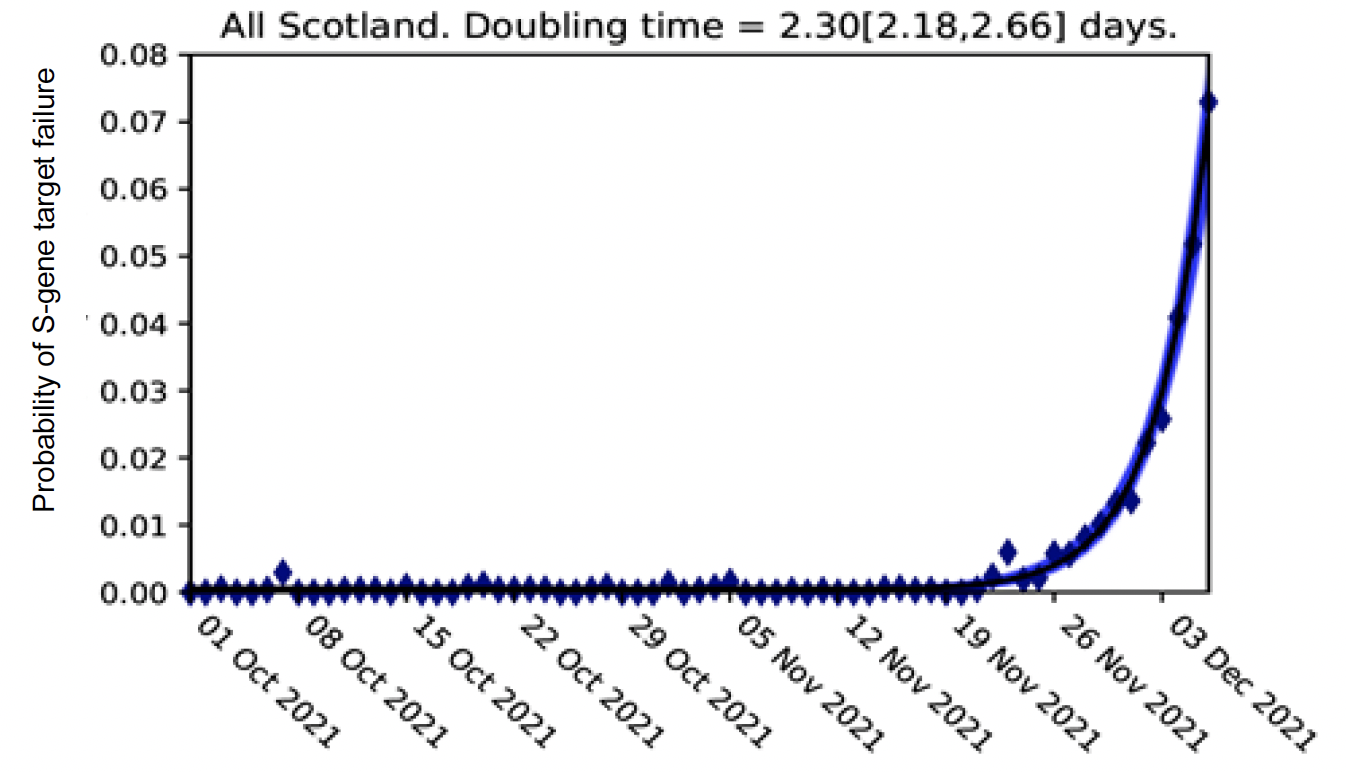
This curve is projected into the future to see the likely evolution of cases in Scotland. Based on projections given the doubling time above, Omicron is likely to make up the majority of cases in Scotland, and this could occur between mid-December and early January 2022.
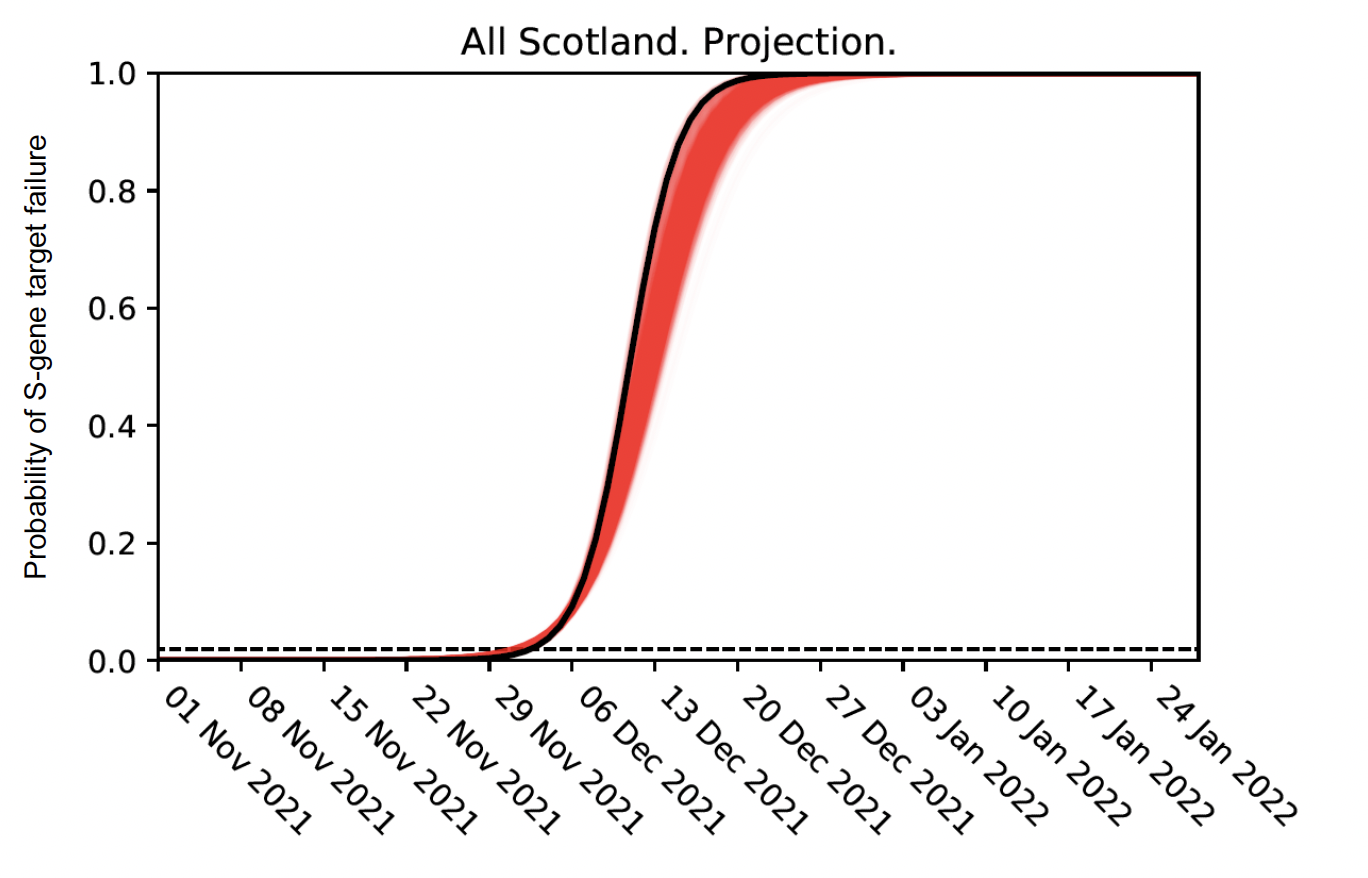
Will Omicron lead to more infections?
Although we are still learning about how many hospitalisations might result from Omicron, given the doubling rate shown above (Figure 14), we can start to estimate the number of infections which might result from this variant in Scotland. Figure 14 sets out our current understanding of the possible number of infections over the next two weeks. We will continue to revise this as more data becomes available.
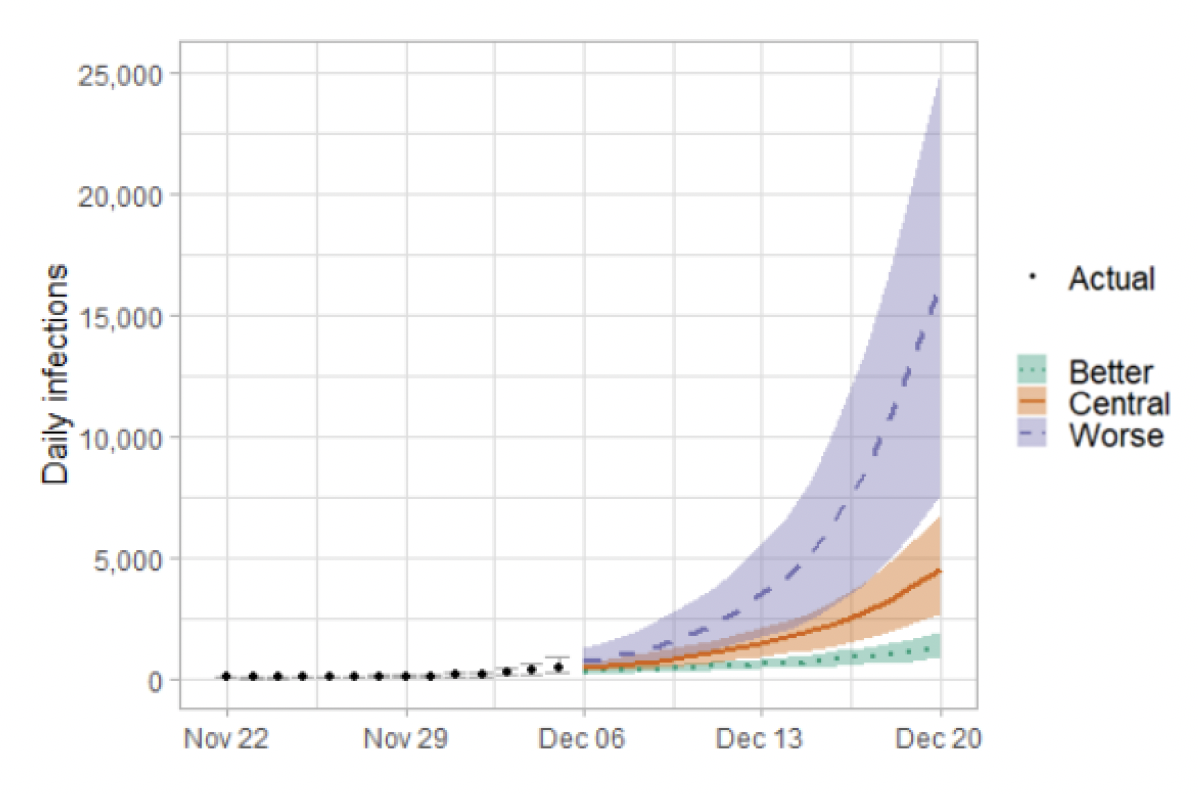
It is likely that a proportion of these infections will result in hospitalisation. To avoid the NHS being put under severe pressure Omicron would need to be substantially less severe than Delta (either because of the characteristics of Omicron or the effectiveness of vaccination against severe disease) given the very substantial number of infections projected in Figure 12.
Other modelling
This section covers some modelling outputs for which the methodology is not affected by which variant is dominant.
What we know about how people's contact patterns have changed
Average contacts from the most recent Panel A cohort of the Scottish Contact Survey (week ending 1st December) indicate an average of 4.8 contacts. This has remained at a similar level compared to the previous Panel A of the survey (week ending 17th November), as seen in Figure 15.
Mean contacts within the home have increased by 7% whereas work contacts have decreased by 8% in the last two weeks. Contacts within the other setting (contacts outside home, school and work) have remained at a similar level over the same period.
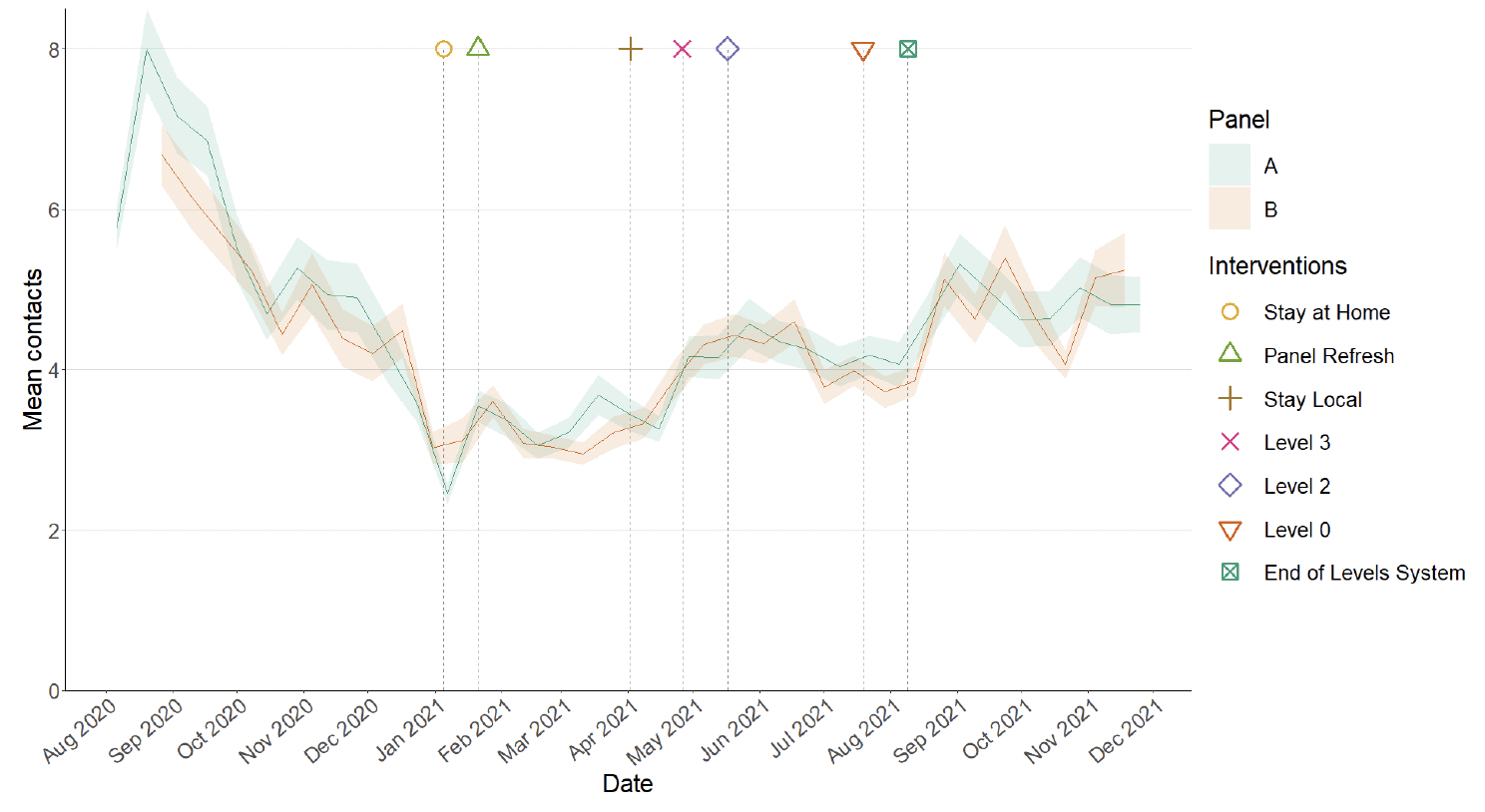
Figure 16 shows how contacts change across age group and setting. Although overall contacts have remained at similar levels compared to two weeks prior, contacts for those in the 18-29 age group have almost doubled with a current level of 6.6 mean contacts. This increase is largely driven by a rise in contacts within the work and other settings.
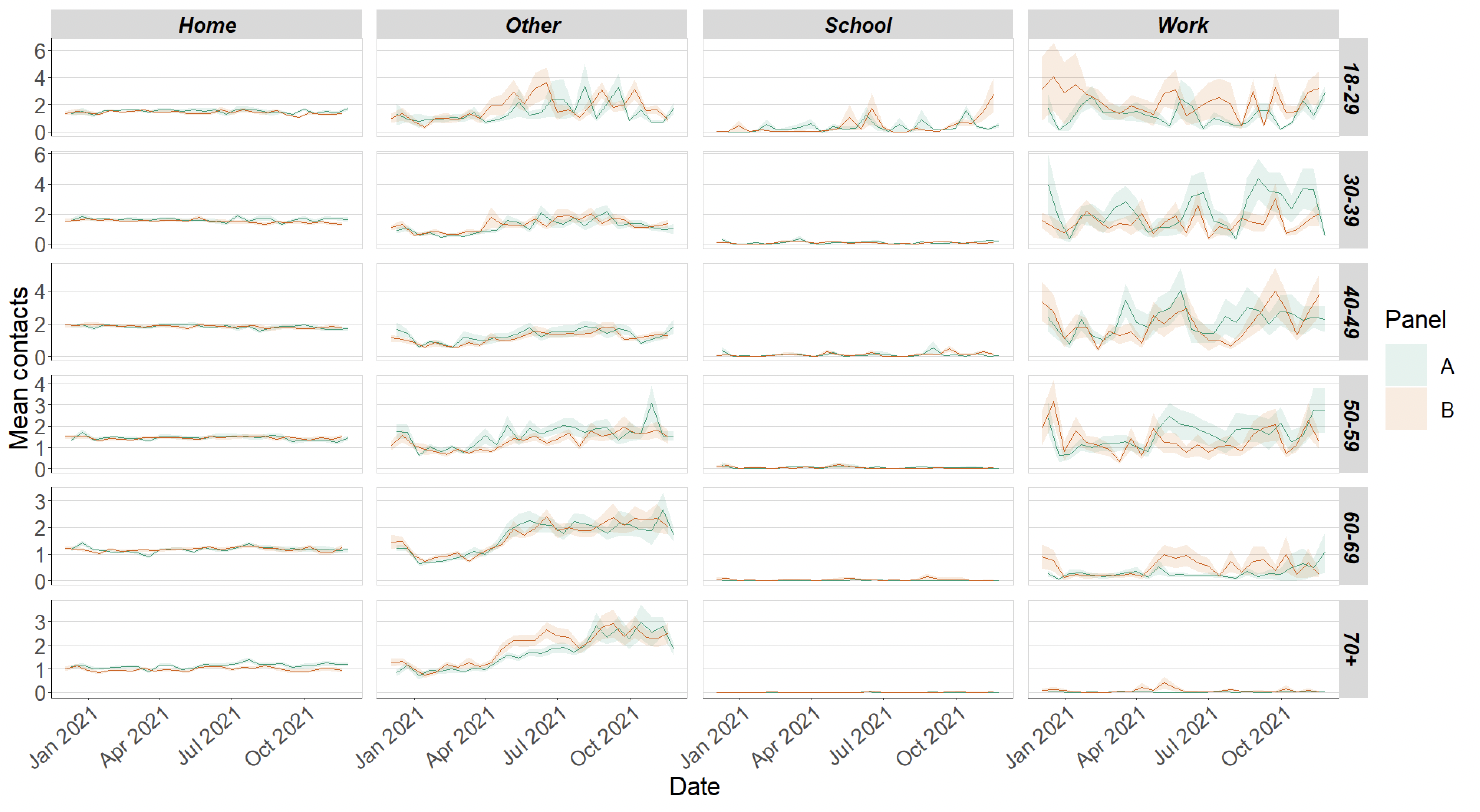
The heatmaps in Figure 17 show the mean overall contacts between age groups for the weeks relating to 11th November - 17th November and 25th November - 1st December and the difference between these periods. The biggest increase interactions is seen between the those under 18 with individuals within the 18-29 age group, with contacts at least three times higher between these age groups.
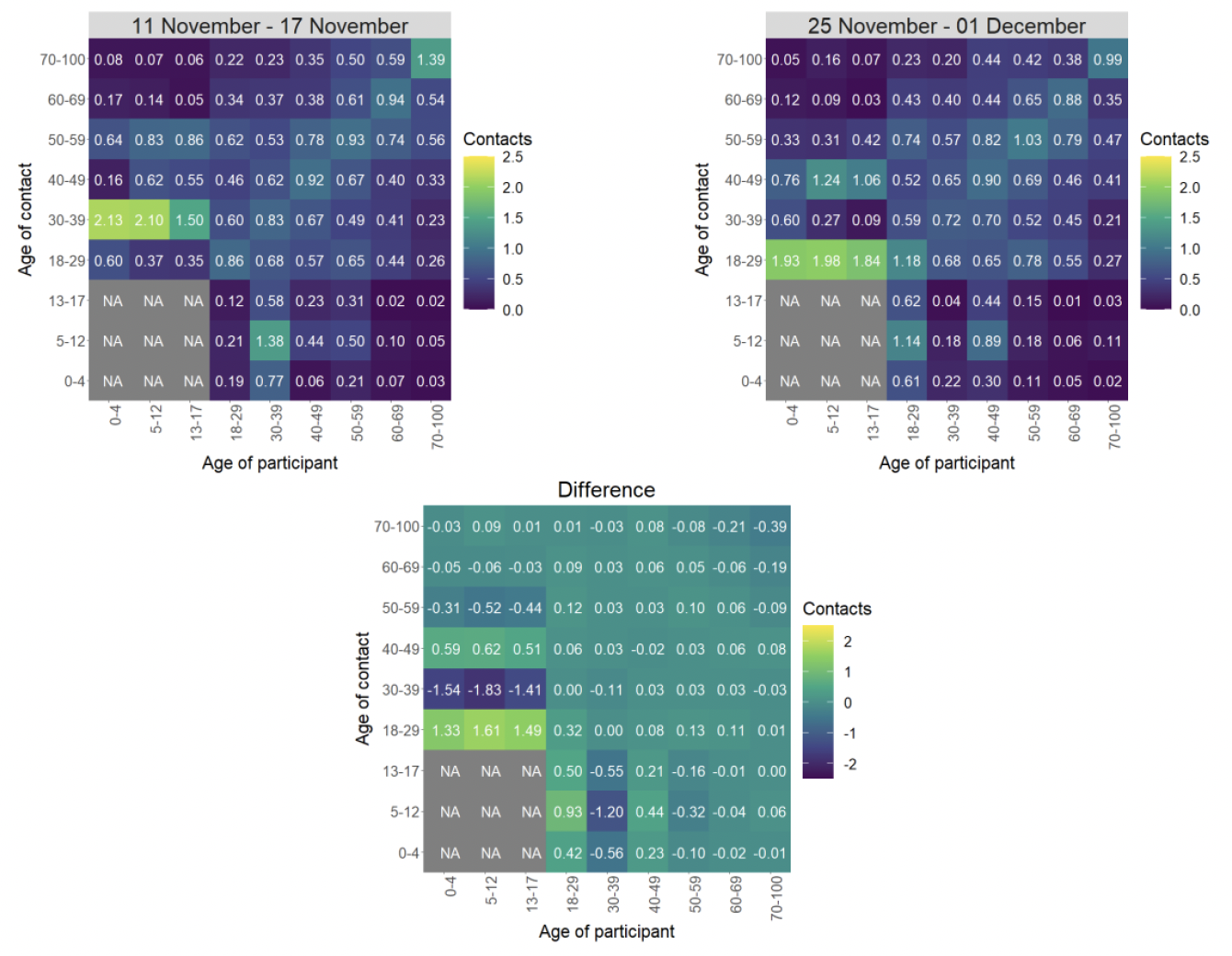
As shown in Figure 18, the biggest changes in the proportion of participants visiting different locations, though slight, is seen in those visiting a shop. Visits to a non-essential shop increased from approximately 42% to 46% and visits to essential shops increased from 86% to 89% in the last two weeks.
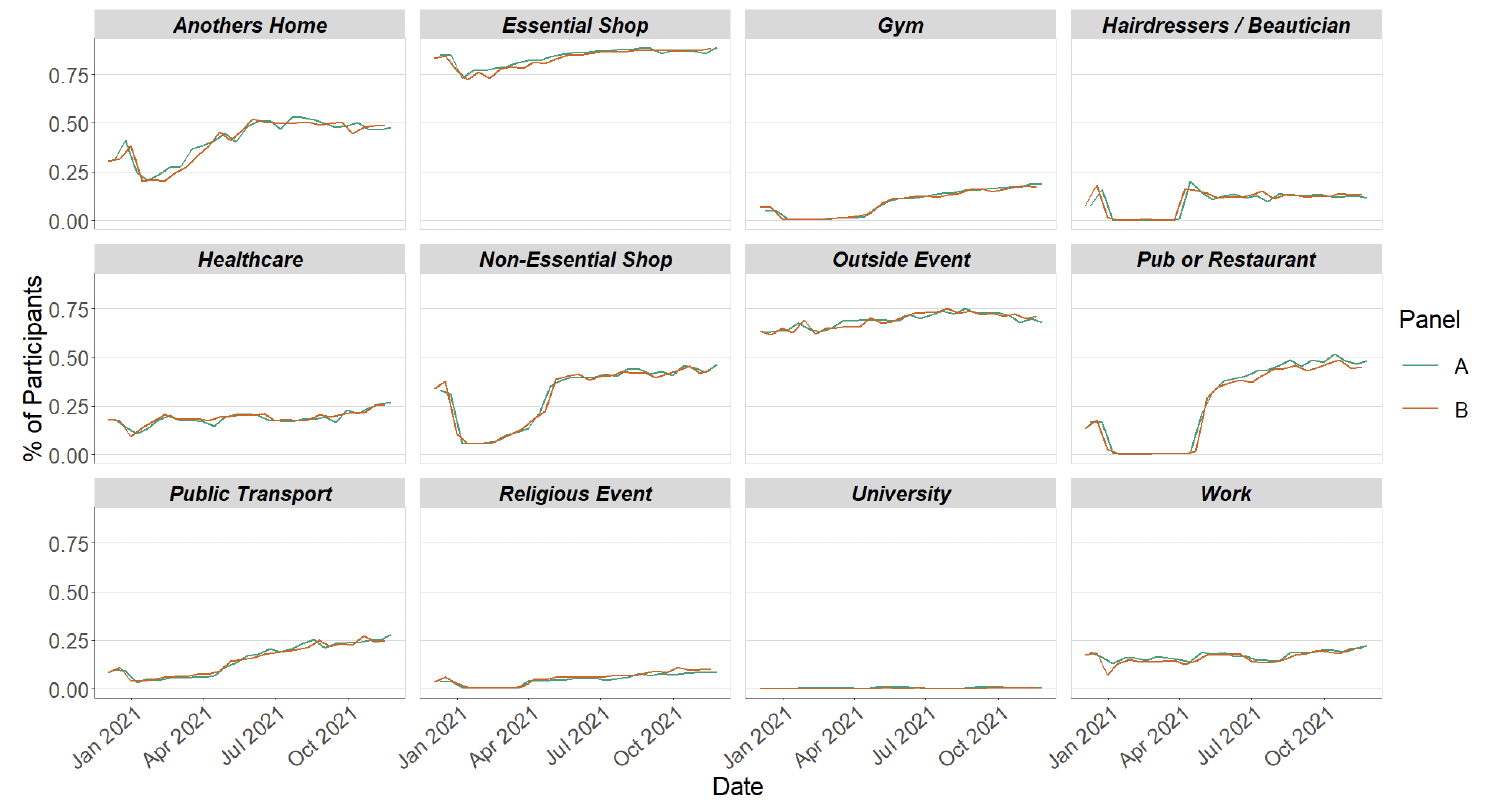
Figure 19 shows the number of people wearing a face covering where they have at least one contact outside of the home. This has increased in the last two weeks from 83% to 85%.
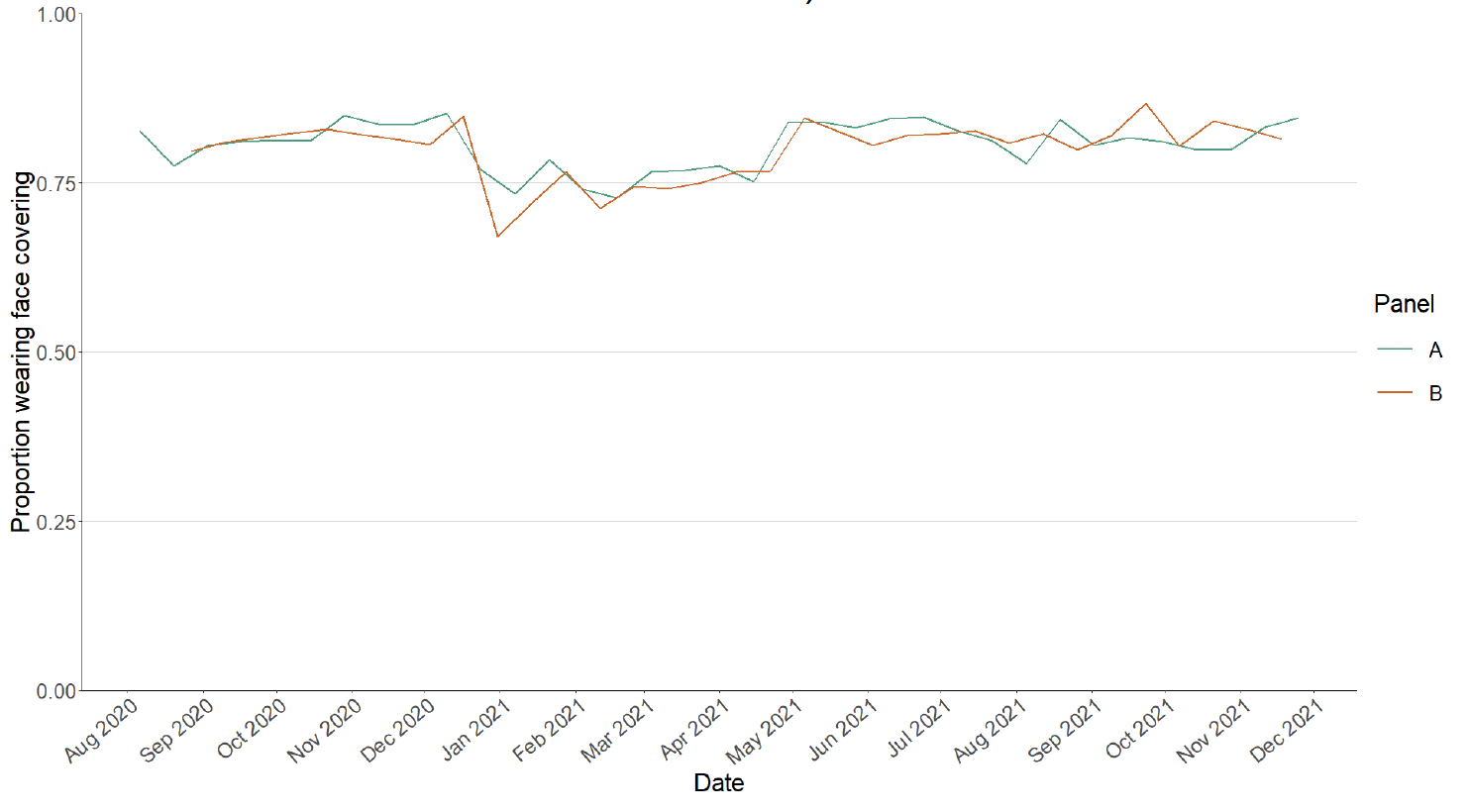
What can analysis of wastewater samples tell us about local outbreaks of Covid-19 infection?
Levels of Covid-19 RNA in wastewater (WW) collected at a number of sites around Scotland are adjusted for population and local changes in intake flow rate (or ammonia levels where flow is not available) and compared to 7-day average daily new case rates derived from Local Authority and Neighbourhood (Intermediate Zone) level aggregate data. See Technical Annex in Issue 34 of these Research Findings for the methodology.
Nationwide, wastewater Covid-19 levels remains at a similar high level as last week, with the week ending on 7th December seeing levels of around 81 million gene copies per person per day (Mgc/p/d), about the same as the 78 Mgc/p/d seen the previous week (week ending 30th November). Recent changes in WW Covid-19 match trends seen in the Office of National Statistics' Coronavirus Infection Survey (ONS CIS) but maintains the relatively high recent level of the WW to new case rate ratio.
Figure 20 shows the national running average trend (over a 7-day period) for the full set of sampled sites, with a small number of unrealistically large outliers excluded. We also consider data from the ONS CIS, with positivity estimates up to 27th November. From this, we see that while both WW viral levels and new case rates do not change greatly this week, this is after a substantial increase in WW Covid-19 and decrease in new case rates the previous week. However, the most recent CIS positivity estimate shows a similar pattern to WW Covid-19 with the estimate levelling off at around 50% higher than two weeks ago[13].
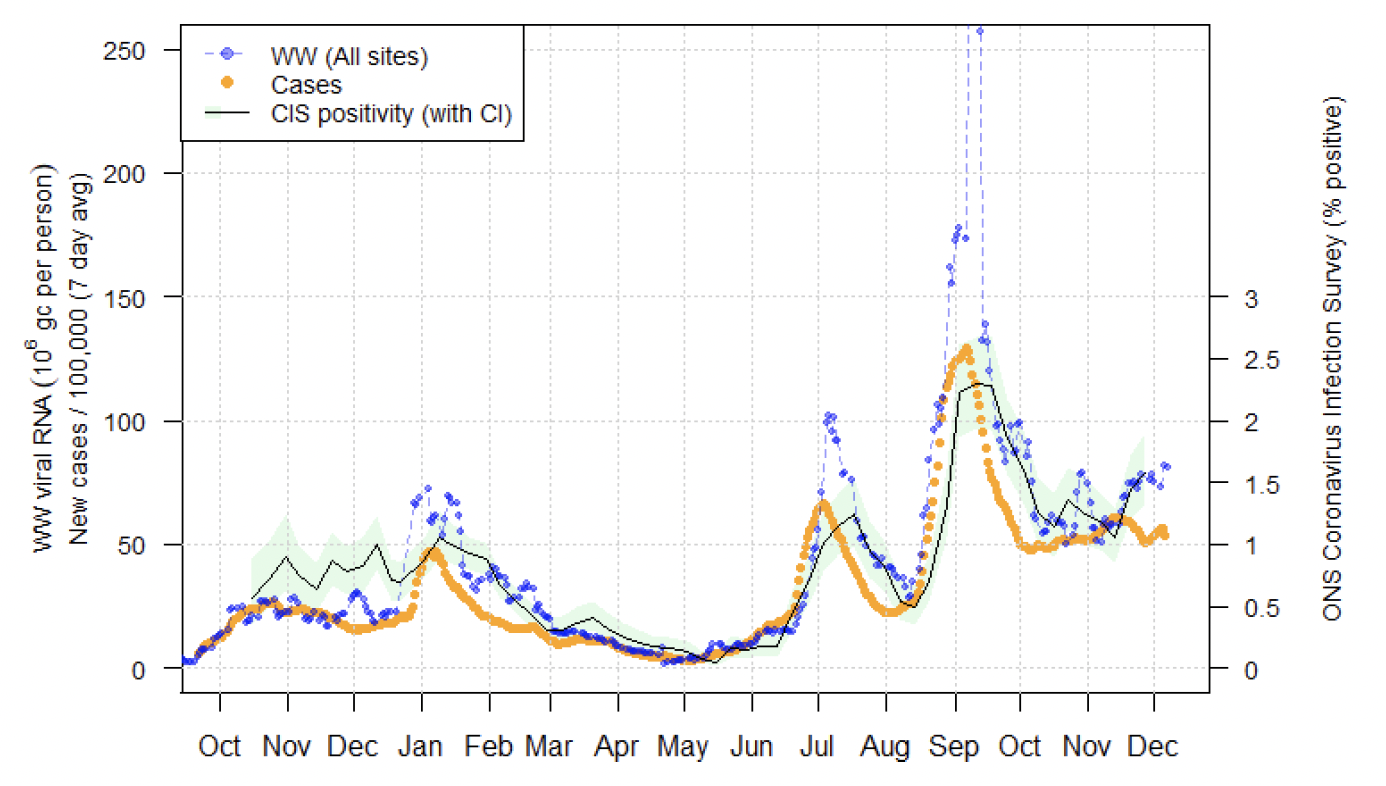
What next?
Modelling will be provided for both the Delta and Omicron variants where possible. As more information on Omicron becomes available this will be incorporated in the different models as and when it is appropriate to do so.
Contact
There is a problem
Thanks for your feedback